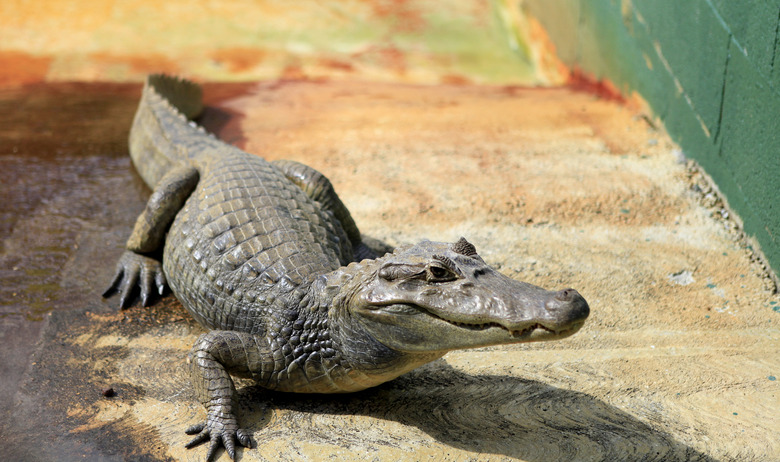Different Types Of Alligators
Two types of alligators inhabit widely separated corners of the world: the American alligator of the southeastern United States and the Chinese alligator of eastern China. (The word alligator comes from the Spanish el lagarto, "the lizard," a name applied by the Spaniards to the gators they first encountered in Florida.)
Though the two alligator species differ significantly in size, both have blunter, broader snouts than their crocodile cousins and are less tolerant of saltwater, lacking the crocs' salt-excreting glands.
While the American alligator has dramatically recovered from its human-caused decline, its Chinese counterpart – critically endangered – has not been so fortunate.
Alligators in the Crocodilian Family Tree
Alligators in the Crocodilian
Family Tree
Alligators belong to the family Alligatoridae, one of the three main branches of the reptilian order Crocodilia; the others are the Crocodylidae, the true crocodiles, and the Gavialidae, which includes the large but slender gharial of South Asia. The gators share Alligatoridae with the six species of caimans, which inhabit southern Mexico and Central and South America.
Alligators reign as the only native crocodilians in all of their Chinese range and most of their American one, but in South Florida the American alligator does overlap with the American crocodile.
Distribution of Alligators
Distribution of Alligators
The American and Chinese alligators the most cold-tolerant of all crocodilians, and reach a greater distance from the equator than any other.
The American alligator inhabits a fairly large range entirely in the U.S. Southeast, from North Carolina, Arkansas and Oklahoma south to southeastern Texas and the tip of Florida.
The Chinese alligator – the only member of the Alligatoridae found outside the Americas – is native to the lower Yangtze River, though its current range is extremely restricted: a few scattered pockets of Anhui Province that together encompass only perhaps two square miles.
The Big One: The American Alligator
The Big One: The American
Alligator
The American alligator is, by a healthy margin, the bigger of the two gator species, and shares with the similarly sized black caiman of South America the title of the heftiest member of the Alligatoridae. Adult males ("bulls") can reach 15 feet or more in length and weigh better than a half-ton.
American alligators eat a wide variety of prey, from insects, frogs and small fish as hatchlings to mammals the size of white-tailed deer and feral pigs when full-grown. Midsize creatures such as turtles, large fish, crabs, raccoons, muskrats and waterfowl constitute much of an adult American alligator's diet. Bigger gators tend to take bigger prey, unsurprisingly.
While they are mainly restricted to freshwater habitats, American alligators do show tolerance for brackish (partly salty) waters such as tidal marshes, and occasionally forage in coastal bays and inlets, where they're known to munch on horseshoe crabs, stingrays and small sharks.
The Small One: The Chinese Alligator
The Small One: The Chinese
Alligator
Chinese alligators are about half the size or less than their American cousins, maxing out around 6 or 7 feet. They're also distinguished from the American alligator by their stubbier and more upturned snouts as well as a bony plate above their eyes, which gives them a more caiman-like appearance.
Residing in floodplain backwaters, lakes and ponds, these little alligators mostly feed on snails and other invertebrates, but also take fish, waterfowl, rodents and any other small prey that ventures within striking distance.
Conservation Status of Alligators
Conservation Status of
Alligators
American alligators were historically heavily hunted for their hides and their meat, declining so significantly by the middle of the 20th century that they were declared endangered in the late 1960s.
Conservation efforts resulted in an encouraging rebound in numbers in the following decades. Today, the species is considered completely recovered with millions inhabiting the Southeast.
Chinese alligators, by contrast, are among the world's most endangered crocodilians: fewer than 100 individuals are thought to remain in the wild. Numerous factors have contributed to their decline, including overhunting and pollution, but massive habitat loss is the main problem.
References
- Crocodilian.com: World Countries Containing Crocodilians
- IUCN Red List: Chinese Alligator
- Earth Touch News: When Crocodiles Go to Sea
- Southeastern Naturalist: Reciprocal Intraguild Predation Between Alligator Mississippiensis (American Alligator) and Elasmobranchii in the Southeastern United States
- Crocodilian.com: Alligator Sinensis
Cite This Article
MLA
Shaw, Ethan. "Different Types Of Alligators" sciencing.com, https://www.sciencing.com/different-types-alligators-8053451/. 29 May 2019.
APA
Shaw, Ethan. (2019, May 29). Different Types Of Alligators. sciencing.com. Retrieved from https://www.sciencing.com/different-types-alligators-8053451/
Chicago
Shaw, Ethan. Different Types Of Alligators last modified March 24, 2022. https://www.sciencing.com/different-types-alligators-8053451/
